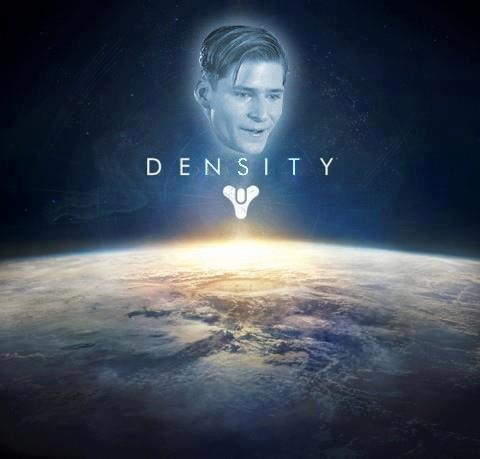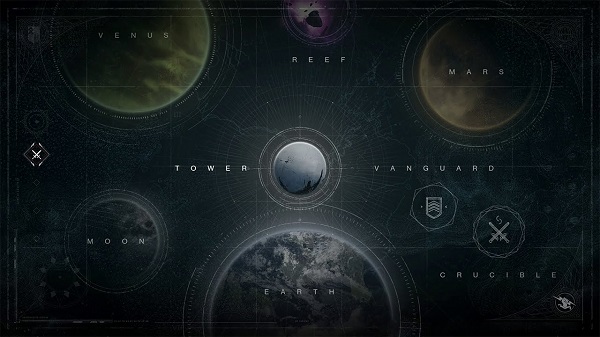Picking up from where I left off on launch day, here’s my slightly more advanced impressions of Bungie’s latest juggernaut. Destiny‘s post-level 20 landscape is markedly different from the early stages, with traditional linear character progression making way for an odd combination of loot drops, faction allegiances, more vendors than you can keep track of and about 500 different currencies. Whereas the general discussion around the game was at first about whether it was any good, now it’s dominated with what’s actually supposed to happen once you hit level cap. To be honest, it’s just made me glad that I didn’t go with a traditional review, but in the end I still need to wrap up my thoughts with some kind of finality.
Ultimately, my opinion is thus: I quite like Destiny… when it’s not being a prick.
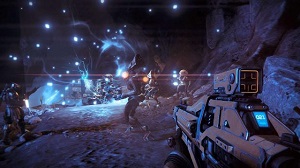 Bungie may have been credited with making the FPS universally appealing with the Halo games, but Destiny turns out to be something of a Trojan horse in that regard. It may have been marketed as the mainstream sensation of the year, but a casual audience was clearly the last thing on Bungie’s mind when they designed this game.
Bungie may have been credited with making the FPS universally appealing with the Halo games, but Destiny turns out to be something of a Trojan horse in that regard. It may have been marketed as the mainstream sensation of the year, but a casual audience was clearly the last thing on Bungie’s mind when they designed this game.
Destiny doesn’t feel like as much a love letter to the hardcore, as an elongated sexting session meant to titillate the most serious of gamers in the hottest and heaviest ways possible: the kind of gamers who run clan play like a military operation and are at their happiest when game systems are complex and time-intensive. While Destiny (oddly) has no real in-game clan functionality, its content is directly geared towards play by fireteams of online friends. It is, in fact, mandatory for the high-level raids, and while Strikes thankfully have matchmaking that’s the only concession to PUGs Bungie seem willing to make: the story missions have no form of matchmaking, meaning that you either corral a bunch of people on your friends list to tackle them, or you do them on your own. When you do the latter, as many prefer or are forced to depending on the availability of friends, is when Destiny‘s most gaping seams start to show.
Much has been made of the fact that Destiny has been in development for six years, and this becomes evident in the final game in a rather unfortunate way. The general design philosophy seems stuck 3-4 years ago, during that unfortunate period where publishers and developers seemed hellbent on forcing players into online multiplayer all the time, with solo play often heavily handicapped.
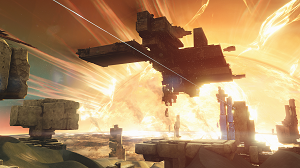 Destiny‘s story missions follow this philosophy, with no apparent scaling in terms of enemy numbers depending on how many people are playing – so when the mission ends with a boss or with an impromptu horde mode as DinkBot scans yet another computer (In other words, most of the missions), solo players are regularly forced to grind their way through ridiculous numbers of enemies clearly meant to be tackled in a group. And if that wasn’t annoying enough, the ‘Darkness Encroaching’/no-spawn zone mechanic ceases to be an interesting tactical tweak as it is in a group, and becomes a massive, massive pain in the arse. It’s a hugely dispiriting experience to be stuck with several waves of enemies, relying on kiting to survive due to the AI’s limited movement range, only to get caught in a bad spot, die and be thrown right back to the beginning of the battle again, knowing that if you were in a group at least then you would have the chance of being revived. The Darkness mechanic is clearly designed to encourage coordination and support play in groups, but it kicks sand in the solo player’s face without even giving them the opportunity to tackle the level with randoms.
Destiny‘s story missions follow this philosophy, with no apparent scaling in terms of enemy numbers depending on how many people are playing – so when the mission ends with a boss or with an impromptu horde mode as DinkBot scans yet another computer (In other words, most of the missions), solo players are regularly forced to grind their way through ridiculous numbers of enemies clearly meant to be tackled in a group. And if that wasn’t annoying enough, the ‘Darkness Encroaching’/no-spawn zone mechanic ceases to be an interesting tactical tweak as it is in a group, and becomes a massive, massive pain in the arse. It’s a hugely dispiriting experience to be stuck with several waves of enemies, relying on kiting to survive due to the AI’s limited movement range, only to get caught in a bad spot, die and be thrown right back to the beginning of the battle again, knowing that if you were in a group at least then you would have the chance of being revived. The Darkness mechanic is clearly designed to encourage coordination and support play in groups, but it kicks sand in the solo player’s face without even giving them the opportunity to tackle the level with randoms.
Weird then, that the strikes do have matchmaking and as a result are easily the game’s highlight. With the general standard of play encouragingly high even for PUGs, these self-contained missions contain some of the game’s most thrilling moments and give everyone a taste of how great Destiny can be. A shame then, that the more advanced Raids are again for friends-list fireteams only. Bungie’s excuse that that they’re way too difficult and demand better coordination than you get with randoms rings especially hollow when their unwillingness to cater to alternative types of play permeates the rest of the game. It’s an archaic system for an online shooter, all the stranger when you consider that every twopenny ha’penny MMO on the market worked out the need for easily accessible group finders and decent scope for solo play some time ago.
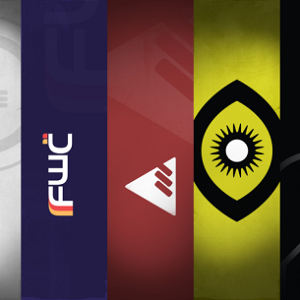 Then you get the baffling levelling system post Level 20, into which you’re thrown with scant explanation and basically required to grind for level-raising bits of gear. It’s a downright weird system, seemingly designed to nudge players even more into Raids and PVP whether they want to or not, demanding a not insignificant time commitment at the mercy of random loot drops – though at least you finally get a chance to actually use some of all these currencies that you’ve been accruing willy-nilly. This obtuse and excessively convoluted endgame system feels like complication for complication’s sake, to draw in the hardcore crowd. It seems as if they’ve noted the traditionally fickle nature of the console community when it comes to online games and are attempting to answer that wanderlust with an experience that not only has more depth, but demands full engagement above and beyond most other comparable games.
Then you get the baffling levelling system post Level 20, into which you’re thrown with scant explanation and basically required to grind for level-raising bits of gear. It’s a downright weird system, seemingly designed to nudge players even more into Raids and PVP whether they want to or not, demanding a not insignificant time commitment at the mercy of random loot drops – though at least you finally get a chance to actually use some of all these currencies that you’ve been accruing willy-nilly. This obtuse and excessively convoluted endgame system feels like complication for complication’s sake, to draw in the hardcore crowd. It seems as if they’ve noted the traditionally fickle nature of the console community when it comes to online games and are attempting to answer that wanderlust with an experience that not only has more depth, but demands full engagement above and beyond most other comparable games.
There’s that word again: ‘demands’. As sweet as Destiny often is to play, there’s a nagging element to the thing, a sense that you’re constantly being reminded as to how Bungie want you to play rather than the other way round. While they’re clearly trying to build a sense of challenge and long-term growth to consoles that you usually see in MMOs, which in itself is a commendable pursuit, they’ve done so at the expense of those who don’t have gaming time on tap and an easily accessible friends list. Bungie may think they’re being forward-looking but Destiny is in many ways stuck in out-of-date game design philosophies from a time when publishers and developers misunderstood the resources and preferences of their own audience.
Hopefully Bungie rethink this approach and open the game out to players in different circumstances, because for all its issues Destiny fair bulges with potential. It looks beautiful, plays wonderfully when it’s not stubbornly asking you to stand around and shoot eighteen thousand enemies, and the Strikes in particular throw up some epic gameplay moments even after numerous runs through each one. While the Crucible PVP is solid if unspectacular, the co-op goodness even with randoms is so potent it’s a shame that Bungie seem so determined to limit people’s ability to take full advantage of it. Matchmaking or some kind of group finder for story missions would be an ideal start, by helping open up the game for the large number of fans frozen out of a lot of the activities on offer.
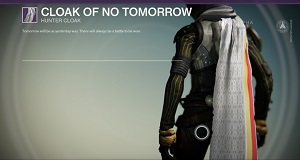 Destiny is an enigma wrapped in a pain in the arse. I can sit here and talk all day about its flaws and missteps, but that doesn’t change the fact that I’ve enjoyed playing it, and will continue to play it. For how long depends on where Bungie want to take it. Bungie aimed for a revolution in how we play console shooters. While often great fun to play, Destiny is not yet there. In many ways it feels like a starter pack for a card or tabletop game: you can play it as is and have some fun with it, but it’s an ultimately barebones experience until you get hold of the additional material. Destiny‘s first two announced expansions, The Dark Below and House of Wolves, are not only being looked to to fill out the vanilla game but are in many ways the key to Destiny‘s long-term success because it gives them a chance to answer the question on everyone’s lips: Now what? If what Bungie is saying is true and that our Destiny journey is only just beginning, are we looking at a future of perpetual grinding for levelling gear with progression determined more by fortunate drops than direct play? Are all these numerous forms of currency, reputation and experience going to coalesce into a legible system? Will we see level cap raises, if that’s even possible in the conventional sense?
Destiny is an enigma wrapped in a pain in the arse. I can sit here and talk all day about its flaws and missteps, but that doesn’t change the fact that I’ve enjoyed playing it, and will continue to play it. For how long depends on where Bungie want to take it. Bungie aimed for a revolution in how we play console shooters. While often great fun to play, Destiny is not yet there. In many ways it feels like a starter pack for a card or tabletop game: you can play it as is and have some fun with it, but it’s an ultimately barebones experience until you get hold of the additional material. Destiny‘s first two announced expansions, The Dark Below and House of Wolves, are not only being looked to to fill out the vanilla game but are in many ways the key to Destiny‘s long-term success because it gives them a chance to answer the question on everyone’s lips: Now what? If what Bungie is saying is true and that our Destiny journey is only just beginning, are we looking at a future of perpetual grinding for levelling gear with progression determined more by fortunate drops than direct play? Are all these numerous forms of currency, reputation and experience going to coalesce into a legible system? Will we see level cap raises, if that’s even possible in the conventional sense?
Bungie have gotten our attention, and now it’s up to the expansions to keep it. Hopefully this will be the case, but one can’t help but suspect that this depends on whether Bungie are willing to make meaningful tweaks, or if they stubbornly cling to design decisions that may alienate significant sections of its audience. There’s a very real chance that even by the time The Dark Below arrives in December, gamers will have by and large moved on to newer, shiner releases, and if Bungie can’t provide a less convoluted and restricted, environment for their game there’s a chance that they may not come back.
